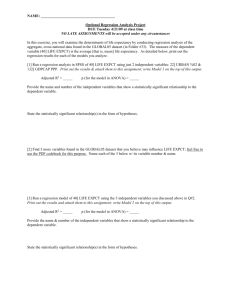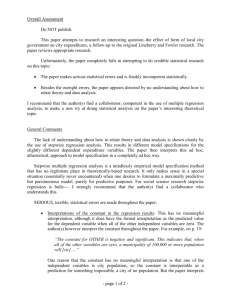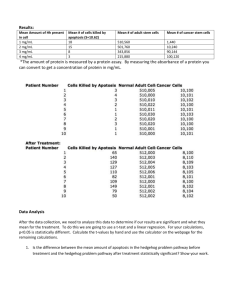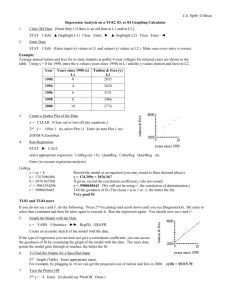Solutions to Regression Exercises
advertisement
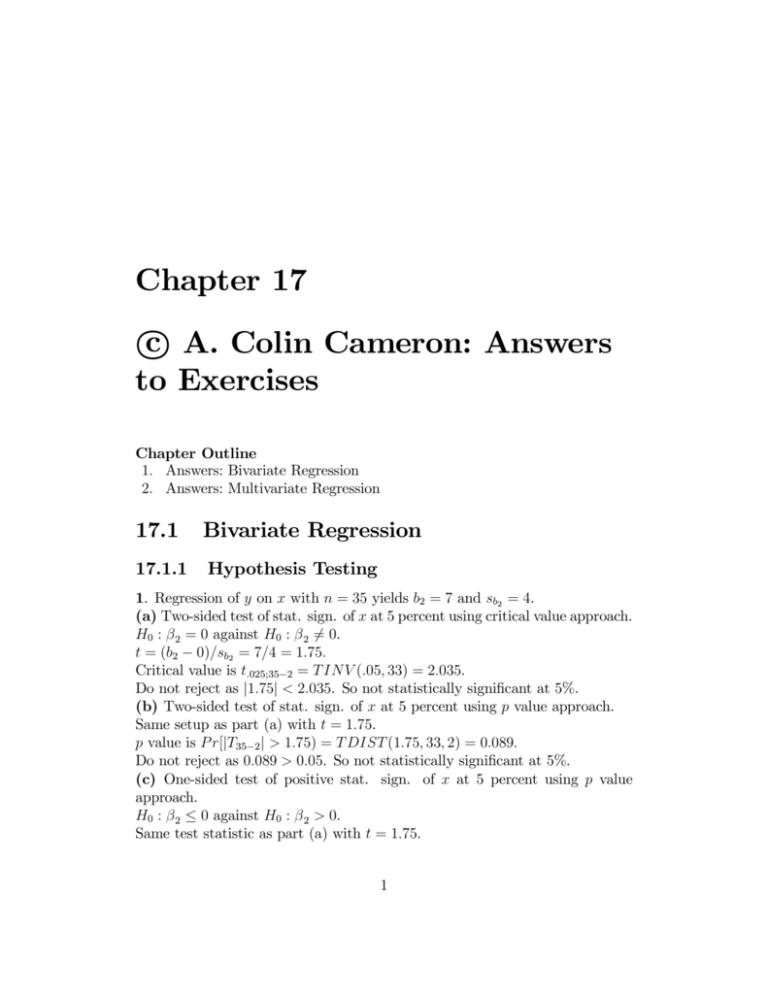
Chapter 17 c A. Colin Cameron: Answers ° to Exercises Chapter Outline 1. Answers: Bivariate Regression 2. Answers: Multivariate Regression 17.1 Bivariate Regression 17.1.1 Hypothesis Testing 1. Regression of y on x with n = 35 yields b2 = 7 and sb2 = 4. (a) Two-sided test of stat. sign. of x at 5 percent using critical value approach. H0 : β 2 = 0 against H0 : β 2 6= 0. t = (b2 − 0)/sb2 = 7/4 = 1.75. Critical value is t.025;35−2 = T IN V (.05, 33) = 2.035. Do not reject as |1.75| < 2.035. So not statistically significant at 5%. (b) Two-sided test of stat. sign. of x at 5 percent using p value approach. Same setup as part (a) with t = 1.75. p value is P r[|T35−2 | > 1.75) = T DIST (1.75, 33, 2) = 0.089. Do not reject as 0.089 > 0.05. So not statistically significant at 5%. (c) One-sided test of positive stat. sign. of x at 5 percent using p value approach. H0 : β 2 ≤ 0 against H0 : β 2 > 0. Same test statistic as part (a) with t = 1.75. 1 c A. COLIN CAMERON: ANSWERS TO EXERCISES 2 CHAPTER 17. ° Critical value is t.05;35−2 = T INV (.10, 33) = 1.692. Reject as 1.75 > 1.692. So statistically significant at 5%. (d) One-sided test of stat. sign. of x at 5 percent using p value approach. Same setup as part (c) with t = 1.75. p value is P r[T35−2 > 1.75) = T DIST (1.75, 33, 1) = 0.045. Reject as 0.045 < 0.05. So statistically significant at 5%. (e) Two-sided test at 10 percent of whether or not slope coefficient equals 1. H0 : β 2 = 1 against H0 : β 2 6= 1. t = (b2 − 1)/sb2 = (7 − 1)/4 = 1.50. Critical value is t.05;35−2 = T INV (.10, 33) = 1.692. Do not reject as |1.50| < 1.692. So not statistically different from 1 at 10%. 17.1.2 Coefficient estimate, standard error and t statistic 2.(a) b2 = 10 and t = 4. Calculate sb2 , the slope coefficient. Since t = b2 /sb2 it must be that sb2 = b2 /t = 10/4 = 2.5. (b) b2 = 10 and p = 0.0575. Calculate the t statistic. n = 35. The p value is the combined area in the left-hand and right-hand tails. This is 0.0575. Now t.0575;35−2 = T IN V (.0575, 33) = 1.968. The t statistic is 1.968. 17.1.3 R-Squared 3. n = 37 and R2 = 0.4. (a) For regression of y on just one regressor x the R2 equals √ the squared correlation coefficient. Thus the correlation coefficient r = ± 0.4 = ±0.632. Note that we do not know the sign of the correlation coefficient without information in addition to R2 . (b) 40 percent of the variance of y is explained by regression on x. (c) If s2y = 100 whatPis T SS, the total sum of squares of y? n 1 1 2 In general s2y = n−1 i=1 (yi − ȳ) = n−1 T SS. 1 Here 100 = 36 T SS implies T SS = 36 × 100 = 3600. (d) Given R2 = 0.40 and part (c), calculate ESS, the error sums of squares. In general R2 = 1 − ESS/T SS. Here 0.4 = 1−ESS/3600 implies ESS/3600 = 0.6 implies ESS = 0.6×3600 = 2160. 17.1. BIVARIATE REGRESSION 17.1.4 3 Inflation and Money Supply Growth Annual data from 1960 to 1998. n = 39. y =INFL. x =GM2. ȳ = 4.19, s2y = 6.19. x̄ = 7.12, s2x = 9.32. y = 2.094 + 0.295x. R2 = 0.13. 1. GM 2t = 100 × (M 2t − M 2t−1 )/M 2t−1 . 2. Money supply growth is more volatile as it has larger variance, since 9.32 > 6.19. 3. Yes. Significant at 5 percent since p = 0.024 < 0.05. Or more work is |t| = 2.361 > t.025;39−2 = T INV (0.05, 37) = 2.026. 4. dy/dx = dIN F L/dGM 2 = b2 = 0.295. A one percent increase in the growth rate of M2 is associated with a 0.295 percent increase in the inflation rate. 5. Question is asking whether or not the slope coefficient equals one. Test H0 : β 2 = 1 against H0 : β 2 6= 1 at 5 percent. t = (b2 − 1)/sb2 = (0.295 − 1)/0.1249 = −0.705/0.1249 = −5.645. Critical value is t.05;39−2 = T INV (.05, 37) = 2.026. Reject H0 as 5.645 > 2.026. Or p = Pr(|Tn−2 | > 5.645) = T DIST (5.645, 37, 2) = 1.90 × 10−6 < 0.05. Reject H0 . Either way yields reject H√ 0 . Conclude that statistically different from one. 2 6. No. R = .13 and r = 0.13 = 0.36 are low. Not highly correlated. 7. The regression cannot discriminate between the two theories as it does not establish causation. 17.1.5 Okun’s Law Annual data from 1960 to 1998. n = 39. y =GDP growth rate. x =CHANGE IN UNEM. ȳ = 4.19, s2y = 6.19. x̄ = 7.12, s2x = 9.32. y = 0.0318 − 1.951x. 1. GDP growtht = 100 × (GDPt − GDPt−1 )/GDPt−1 . 2. Yes. Significant at 5 percent since p = 4.43 × 10−11 < 0.05. Or more work is |t| = 9.184 > t.025;39−2 = T DIST (0.05, 37) = 2.026. Is the change in unemployment statistically significant at 5 percent? 3. Question is asking whether or not the slope coefficient equals −2. Test H0 : β 2 = −2 against H0 : β 2 6= −2 at 5 percent. t = (b2 − −2)/sb2 = (−1.951 − −2)/0.212 = −0.049/0.212 = −0.23. c A. COLIN CAMERON: ANSWERS TO EXERCISES 4 CHAPTER 17. ° Critical value is t.05;39−2 = T INV (.05, 37) = 2.026. Do not reject H0 as 0.23 < 2.026. Or p = Pr(|Tn−2 | > 0.23) = T DIST (0.23, 37, 2) = 0.82 > 0.05. Do not reject H0 . Either way do not reject H0 . Conclude that not statistically different from −2. 4. Increase in unemployment rate from 5 percent to 7 percent in a year implies change in unemployment rate equals 7 − 5 = 2. Predicted yb = 0.0318 − 1.951 × 2 = −3.87. Predicted reduction in the growth rate of real GDP is 3.87 percent. 17.2 Multivariate Regression 17.2.1 Hypothesis Testing 1. y = b1 + b2 x2 + b3 x3 with b2 = 20, t2 = 2.5, b3 = 40, t3 = 1.5. n = 40. (a) Two-sided test of stat. sign. x2 and x3 at 5% using critical value approach. H0 : β j = 0 against H0 : β j 6= 0. Critical value is t.025;40−3 = T IN V (.05, 37) = 2.026. For x2, t2 = 2.5 and |2.5| > 2.026. So x2 statistically significant at 5%. For x3, t3 = 1.5 and |1.5| < 2.026. So x3 not statistically significant at 5%. (b) Two-sided test of stat. sign. of x2and x3 at 5% using p value approach. For x2, p value is P r[|T40−3 | > 2.5) = T DIST (2.5, 37, 2) = 0.017 < 0.05. For x3, p value is P r[|T40−3 | > 1.5) = T DIST (1.5, 37, 2) = 0.142 > 0.05. So x2 statistically significant at 5% and x3 not statistically significant at 5%.. (c) Test H0 : β 3 = 20 against H0 : β 3 6= 20 at 10 percent. t = (b3 − 20)/sb3 . The problem is what is sb3 ? Recall that t3 = b3 /sb3 , so here 1.5 = 40/sb3 . It follows that sb3 = 40/1.5 = 26.67. Thus t = (40 − 20)/26.67 = 0.75. Critical value is t.05;39−2 = T INV (.05, 37) = 2.026. Do not reject H0 as 0.75 < 2.026. Or p = Pr(|Tn−2 | > 0.75) = T DIST (0.75, 37, 2) = 0.458 > 0.05. Do not reject H0 . Either way do not reject H0 . Conclude that not statistically different from −2. 17.2. MULTIVARIATE REGRESSION 17.2.2 5 F-test, R-squared and Adjusted R-squared 2. n = 35. Regress y on x2 yields R2 = 0.40 with k = 2. Regress y on x2 and x3 yields R2 = 0.41 with k = 3. (a) F test of whether or not x2 stat. sign. at 5% in regression of y on x2. H0 : β 2 = 0 against Ha : β 2 6= 0. F = [R2 /(k − 1)]/[(1 − R2 )/(n − k)] = [0.40/(2 − 1)]/[(1 − 0.40)/(35 − 2)] = [0.40]/[0.60/33] = 22. (b) F test of whether or not x2 and x3 are jointly stat. sign. at 5% in regression of y on x2 and x3. H0 : β 2 = 0, β 3 = 0 against Ha :At least one of β 2 6= 0, β 3 6= 0. F = [R2 /(k − 1)]/[(1 − R2 )/(n − k)] = [0.41/(3 − 1)]/[(1 − 0.39)/(35 − 3)] = [0.41/2]/[0.59/32] = 13.83. (c) In genera R̄2 = R2 − [(k − 1)/(n − k)](1 − R2 ). Just x2 : R̄2 = 0.40 −[(2 −1)/(35 −2)](1 −0.40) = 0.40 −[1/33]×0.60 = 0.382. Both x2 and x3 : R̄2 = 0.41−[(3−1)/(35−3)](1−0.41) = 0.41−[2/32]×0.59 = 0.373. Prefer the model with just x2 on the basis of R̄2 , as it has higher R̄2 . 17.2.3 Republican Voting n = 50. V OT EREP U B = 58.5814+0.27829×P OP CH−0.0014034×SCHOOL (20.63) (3.22) (−2.24) R2 = 0.258. 1. Yes. The two regressor variables are statistically significant at 5 percent. Critical value is t.025;50−3 = T IN V (.05, 47) = 2.012. 2. Yes. The coefficients of POCCH and SCHOOL have the expected signs and are statistically significant at 5 percent. (Here best to use a one-sided test in which case the critical value is t.05;50−3 = T IN V (.10, 47) = 1.678). 3. Test H0 : β 2 = 0, β 3 = 0 against Ha :at least one β 2 , β 3 6= 0. From formula sheet F = [R2 /(k − 1)]/[(1 − R2 )/(n − k)] = 8.17. Yes. Reject H0 at 5 percent as F = 8.17 > F IN V (0.05, 2, 47) = 3.195. or reject H0 at 5 percent as p = F DIST (8.171, 2, 47) = 0.0009 < 0.05. 4. Prediction for Canada is V OT EREP UB = 58.5814 + 0.27829 × 10 − 0.0014034 × 4000 = 55.75 > 50.00. Yes. The model predicts that more than 50 percent would vote Republican. c A. COLIN CAMERON: ANSWERS TO EXERCISES 6 CHAPTER 17. ° [A better answer would formally test whether the difference from 50 is statistically significant. There is not enough information here to do that.] 5. Positive: on average as income increases people are more likely to vote Republican. [This result may not necessarily hold once one controls for POPCH and SCHOOL, but I expect it would.] 6. R2 always increases (or more precisely never decreases) when additional regressors are added. So the increase is not a surprise. The question is whether going from 0.250 to 0.270 is a big or small decrease. 7. Use R̄2 = R2 − [(k − 1)/(n − k)](1 − R2 ) which adjusts for model size. Without income R̄2 = 0.258 − [2/47] × 0.742 = 0.226. With income R̄2 = 0.270 − [3/47] × 0.730 = 0.223. The model without income is preferred as R̄2 is larger.
